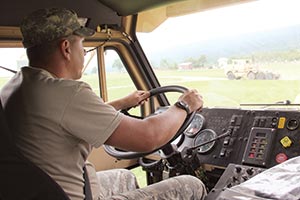Senior Reporter
Responses Mixed on Federal Pilot Project to Allow Young Vets to Run Interstate

This story appears in the Oct. 3 print edition of Transport Topics.
While the idea clearly has strong supporters, not everyone agrees that allowing young drivers behind the wheel of big rigs is either safe or a wise solution to one of trucking’s biggest headaches: the driver shortage.
That was the range of responses to federal regulators’ plans for a pilot project allowing veterans to work as interstate drivers that poured in by the Sept. 21 deadline.
Some view the notion of allowing truck drivers between the ages of 18 and 21 with military driving experience to operate heavy trucks as not only safe, but an idea that could help stem a fast-growing truck driver shortage.
But, as evidenced in written comments, others are concerned that it might spill immature drivers on the nation’s highways, stir up public outrage or even be regarded as an effort to appease large motor carriers concerned about the shrinking driver pool.
The Federal Motor Carrier Safety Administration announced its three-year pilot to use 18- to 21-year-olds in August in response to a FAST Act mandate that called on the agency to conduct a trial that would compare the safety record of young drivers with their older counterparts to determine whether age is a critical safety factor.
Federal regulations currently do not permit drivers younger than 21 to drive in interstate commerce.
But the notion seems every bit as controversial today as it was in 1975, when a federal review concluded that young drivers “lack the general maturity, skill and judgment that is necessary in handling commercial motor vehicles.”
Today, American Trucking Associations said it “strongly supports” the idea, but with certain tweaks, such as expanding the pilot to include under-21 applicants with Professional Truck Driver Institute- certified course training, pre- qualifying under-21 applicants prior to hiring and allowing all motor carriers into the pilot that are eligible to participate.
ATA also said the pilot should establish a control group that represents a “true” picture of over-21 interstate drivers and consider accountability when analyzing crash data.
Officials at Omaha, Nebraska-based truckload carrier Werner Enterprises had similar thoughts on the pilot: “Despite the fact that program participants may have operated equipment equivalent to a commercial motor vehicle while in military service, they may have not received training on federal hours-of-service requirements for interstate drivers.”
In addition, Werner said FMCSA also may wish to consider requiring program participants to be trained on how to utilize electronic logging devices as required by the pilot program, and any other safety equipment utilized by the participating motor carrier.
Other supporters of the pilot include the Commercial Vehicle Training Association, the American Association of Motor Vehicle Administrators and several small truckers.
The Owner-Operator Independent Drivers Association and the Truckload Carriers Association expressed reservations, however.
“OOIDA is concerned with the reasoning behind this pilot program,” the group said. “Is it truly to help military veterans or to fulfill the economic interests of a few larger motor carriers and a perceived driver shortage?”
OOIDA said it agrees that military experience often lends itself to a successful career within the trucking industry, but that it had many reservations about lowering the age of drivers in order to “combat a perceived driver shortage, especially when a poorly executed program could endanger all highway users, including pilot program participants.”
Meanwhile, TCA said that it supported the program “in principal.”
“Plain and simple, TCA is concerned with the prospect of locating 18- to 20-year-old drivers with the appropriate background so that they would qualify for this study,” TCA said. “Our association members have wondered aloud if these drivers exist also, whether or not a viable pilot program can be achieved by establishing driver parameters for a population that may not exist.”
Some nonprofit safety groups, including the National Safety Council, Advocates for Highway and Auto Safety, Parents Against Truckers and Truck Safety Coalition expressed doubts that the young drivers would be safe.
The Advocates for Highway and Auto Safety said crash data show that commercial motor vehicle drivers ages 19 to 20 are about six times more likely to be involved in police-reported injury and fatality crashes per 100 million vehicle miles traveled, compared with all other truck drivers age 21 and older.
Comments by Deborah Hersman, CEO of NSC and former chairman of the National Transportation Safety Board, showed the group supports maintaining the current 21-year-old age requirement for interstate truck drivers.
“The data are clear; teen and novice drivers are more dangerous, and CMV crashes are more likely to result in fatalities,” the group said. “While NSC understands the trucking industry’s need to maintain an eligible workforce, we believe that combining teens and CMVs creates an unacceptable level of risk.”
FMCSA said in August that a driver participating in the pilot program would not be permitted to transport passengers or hazardous cargo. It also said it plans to create a working group to consult with for conducting, monitoring and evaluating the pilot program.

